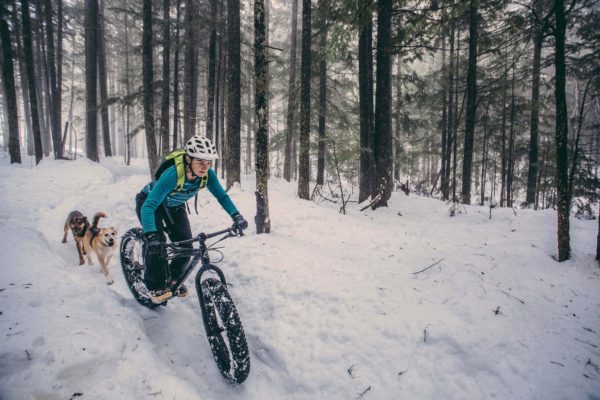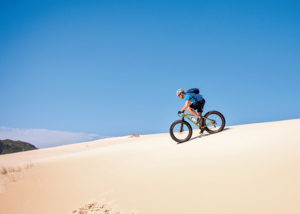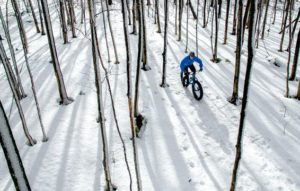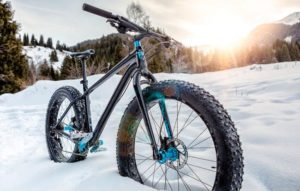Do you remember the first time you saw a fat bike? On first impression, it is easy to think they look like some weird fad that will come and go. However, the past few years have proven that this isn’t the case. Gaining in popularity, fat biking has become a category all in its own.
The obvious advantage of a fat bike is the ability to ride in snow and sand more easily that with a regular mountain bike. No matter how funny you think they may look, it’s worth giving a try. Maybe fat really is the new skinny.

What is fat biking?
A fat bike is an off road bicycle designed to accommodate oversized tires, typically 3.8 inches or larger. The first thing you’ll notice, other than the massive tires, is the wide fork build to fit the large tires as well as the low ground pressure. These tires can be run as low as 5 psi to provide the ultimate traction in snow, sand, or mud.
Although the general idea of fatbiking has been around since the early 1900s, they first became commercially popular with Surly Bike’s release of the Pugsley frame in 2005. The rest, as they say, is history.
Why you should try fat biking
It’s a great workout
Staying fit over the winter in places where it gets cold and snowy is tough. If you love the freedom that cycling brings, it can be hard to find the motivation to go to the gym or hop on a stationary bike. Fatbiking not only allows you to ride outside all winter, but it’s also a great workout. In soft conditions it can be tough going, but you will be expending a ton of energy in a short about of time. You will also be working on your balance and core strength making a great whole body workout. Come spring and hop back on your regular bike, you’ll feel light and fast, and you’ll have maintained a great fitness level.
It gets you outside
No need to mope around the house as soon as there’s snow on the ground. Fat bikes are like the monster trucks of the cycling world – they will get you through just about anything. Getting out in the sunshine and fresh air, even if it’s cold, is the best way to make the most of every season. Research has also shown that the cold can actually raise your metabolism as your body works to keep warm, which means burning extra calories!
 It builds your endurance
It builds your endurance
Fat biking will make you a stronger rider and build your endurance, both physically and mentally. Riding in the elements on a bike that requires constant spinning (there’s pretty much no coasting) will up your overall toughness level. Plus, if you ever hit a race in your regular season that has bad weather, it’ll be nothing compared to your miles put in with the snow and mud.
You can ride a fat bike all year round
There are those that choose to ride a fat bike all year due to the feeling of the bike, particularly the stability and suspension of the fat tires. Many models can also accept multiple wheel sizes, so you can switch out your tires for skinnier ones before hitting the dry single track.
How to choose a fat bike
With the rise in popularity, the variety of fat bikes available has made choosing one a little more complicated. Although we can give you the basic features to look out for, a visit to your local bike shop will help you make a more informed decision. It’s also great to try one out before buying to ensure you enjoy the feel of it.
- Frame capability – Think about how much “flotation” you want. Generally speaking there are two sizes: those that accommodate 4 inch
 ires, and those for 5 inch or wider tires. If you’re sticking to groomed or somewhat packed down trails, 4 inch tires will be all you need.
ires, and those for 5 inch or wider tires. If you’re sticking to groomed or somewhat packed down trails, 4 inch tires will be all you need. - Rigid frame or suspension – Most fat bikes are a rigid frame as the tires and low pressure make up for the lack of suspension, but many are now also equipped with a suspension fork. Going with a frame with suspension can be a great option for really rough terrain, or if you plan on riding the bike all year round.
- Frame size – As with any bike, you want to ensure you get the right size for you, and it’s always worth having a proper bike fit to ensure maximum efficiency. Most frames are set up with similar geometry to a mountain bike to remain stable over rough terrain.
- Tires – As with road and mountain bike, fat bike tires can come in a variety of designs. Most are either clincher or tubeless. You’ll also want to take a look at size. The general size is 4 inches, but there are both smaller and larger tires available depending on the terrain you’ll be riding.
- Brakes – If you’re planning on riding in the Arctic, or anywhere else that experiences freezing temperatures, then you’ll want to go with the basic mechanical, cable-actuated disc brakes. Hydraulic disc brakes are a great option, but only if you’re sticking to warmer climates as mineral oil can easily freeze.
Check out this list of the top ten best fat bikes for more information.
Fat biking really has become it’s own sport, and with good reason. It’s as much fun as it looks, and there are a ton of events that now incorporate fat bikes to get you through the long cold winters. Additionally, many bikepackers are choosing fat bike frames to widen their adventure possibilities. Check out the video below for some added inspiration to get you going.